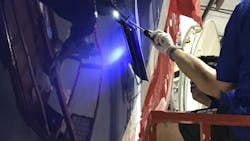A Closer Look at Finlets – Aircraft ‘Fins’ for Sustainable Aviation
Avelo Airlines recently announced it will be the first airline to install fuel- and emissions-reducing aircraft “fins” known as “Finlets” fleetwide.
The airline completed its first Finlet installation in September 2023 and expects its entire fleet of 16 Boeing Next-Generation 737-700s and 737-800s to be retrofitted by the end of the year.
After the entire fleet is fitted with Finlets, the airline estimates an annual reduction of 11 million pounds of carbon emissions and 560,000 gallons of fuel.
Finlets are patented by Vortex Control Technologies (VCT). The company focuses on aerodynamically controlling vortices emanating from the aft fuselage of aircraft. (More on that later.)
VCT CEO Gil Morgan said, “The value proposition for Finlets is clear, our proven technology reduces carbon emissions affordably, while being simple to install and even easier to maintain.”
Let’s take a closer look:
What are VCT Finlets and what do they do?
VCT Finlets are a patented array of fins that reshape the airflow to improve the pressure distribution and reduce flow separation and thereby reduce pressure drag (aerodynamic drag).
What are the benefits of Finlets?
A reduction in aerodynamic drag results in less aircraft fuel consumption and fewer carbon emissions, while enhancing an aircraft’s range, performance and endurance.
Where on the aircraft are Finlets installed?
On the aft fuselage of the aircraft.
How many fins are in an array? About how small are they?
A Finlet array consists of between three to six Finlets depending upon the aircraft type, series and model. Typically, Finlets are 25 inches long, 2.5 inches tall.
Do Finlets differ from one aircraft to another? If yes, how so?
VCT, using its proprietary technology, is able to design a Finlet configuration that will minimize the aerodynamic drag of any aircraft. Designs are done using the company's proprietary knowhow in conjunction with computational fluid dynamics (CFD).
Finlet size and shape are customized and vary sightly depending upon the aircraft type, make, model, series and position on the fuselage.
CFD and VCT’s knowhow
Proprietary technologies enable engineers to model, predict, redirect and control aircraft vortex flow in order to reduce fuel consumption and carbon emissions.
A vortex is a spinning, often turbulent, flow of fluid. Any spiral motion with closed streamlines is vortex flow.
For a more in depth look at finlets and Avelo Airlines’ utilization of them, AMT went to VCT CEO Gil Morgan for a Q&A:
AMT: For those who don’t know the science, say more about “vortex flow.”
Morgan: In physics and engineering “fluid mechanics” refers to the mechanics of fluids and the forces on them. Fluids can be liquids, gases or plasmas. Air is considered a gas. Aerodynamics is a branch of fluid mechanics.
All aircraft produce vortices – not just one vortex but multiple – in flight, particularly at the wing tips, wing to fuselage interface, and aft fuselage.
Vortex flow is a significant source of aircraft drag, particularly on aircraft with upswept afterbodies. including the C-130, used for global airlifts, and C-17, a flexible cargo aircraft. Both incorporate cargo doors.
AMT: Why are Finlets beneficial for the B-737?
Morgan: The 737NG has essentially the same aft fuselage as the original 737 designed in 1966. In that era the aft fuselage incorporated considerable upsweep in order to accommodate the design constraints relevant to the aircraft at that time. This feature provided an opportunity for Finlets to reduce drag.
AMT: What about FAA Certification?
Morgan: The FAA certification of Finlets on 737NGs is the culmination of over a decade-long design effort involving wind tunnel testing, computational fluid dynamics, and comprehensive U.S. Air Force and FAA flight tests on the C-130, C-17 and 737NG aircraft.
The FAA STC for the 737-700 was issued in 2018. Others followed in 2023, including the 800 and 900ER.
AMT: Which airline was the first to install Finlets and when? Are they still in place today?
Morgan: Southwest Airlines first installed Finlets on the 737-700 in October 2018 and these aircraft are still flying with Finlets today.
AMT: Who else is utilizing Finlets?
Morgan: Finlets have also flown on a BBJ-1 since July 2018.
Avelo Airlines became the second airline to install Finlets and the first 737-800 operator to utilize Finlets. Avelo completed its first Finlet installation in September 2023 and expects its entire fleet of 16 Boeing Next-Generation 737-700s and 737-800s to be retrofitted by the end of the year.
Delta was the first to install Finlets on the 737-900ER in January 2024 and will begin 737-800 installations in May.
AMT: When an aircraft is equipped with Finlets, what are the basic components?
Morgan: Three to five Finlets. For some models, some or all of the VGs above the horizontal stabilizer are removed further reducing drag.
AMT: Who installs the Finlets?
Morgan: Finlets can be installed by the airline or MRO in one shift, 16-22 man-hours, outdoors.
AMT: What’s involved in the installation?
Morgan: Finlets are installed with standard fasteners at an unpressurized part of the aircraft fuselage.
AMT: How long does installation take?
Morgan: Less than one day per aircraft,
AMT: Who maintains and inspects the Finlets?
Morgan: VCT’s Finlet system is a passive system. There’s no impact to aircraft systems or maintenance costs other than routine visual inspections.
AMT: What’s next for Finlets?
Morgan: Getting the word out so airlines can start to incorporate the technology into their fleets which will provide substantial benefits to our environment, along with conserving resources and improving bottom-line financial performance.
AMT: What’s the ultimate goal for Finlets?
Morgan: It is clear that, as an industry, we need to do all we can to protect our environment. VCT’s technology accomplishes this by reducing fuel consumption, carbon emissions, and operating costs while enhancing aircraft range, performance and endurance.
About the Author
Rebecca Kanable
Assistant Editor
Rebecca Kanable, a veteran journalist, worked with Endeavor Business Media's aviation group from 2021 to 2024 as assistant editor of Airport Business, AMT and Ground Support Worldwide. She previously worked for various publications, including trade magazines and newspapers.

